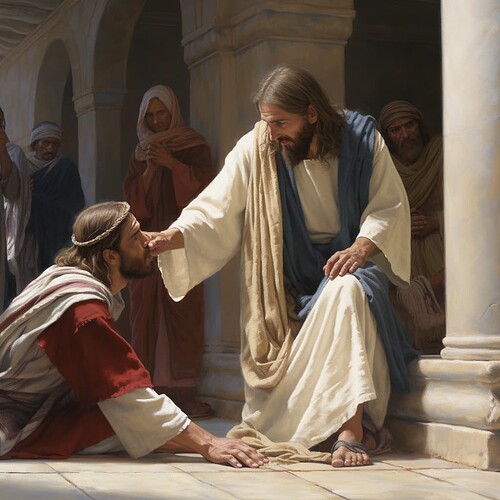![]() January 07: Matthew 9 - Miracles and Teachings of Jesus -Experiencing the Transformative Power of Faith
January 07: Matthew 9 - Miracles and Teachings of Jesus -Experiencing the Transformative Power of Faith
 Introduction
Introduction
Today, we immerse ourselves in Matthew 9, a chapter rich with stories of healing, the calling of Matthew, and profound teachings of Jesus. This chapter illustrates the transformative power of faith and compassion.
To follow along with our reading plan, view the schedule here: AIgniteScripture Reading Plan.
 Matthew 9: Healing Miracles
Matthew 9: Healing Miracles
In Matthew 9, we witness several of Jesus’ healing miracles, including the healing of a paralytic, a woman with a bleeding issue, and the raising of Jairus’ daughter. These miracles demonstrate Jesus’ compassion and authority.
Key Verse: “Just then a woman who had been subject to bleeding for twelve years came up behind him and touched the edge of his cloak.” — Matthew 9:20
 The Calling of Matthew
The Calling of Matthew
A significant moment in this chapter is the calling of Matthew, a tax collector. This story underscores Jesus’ mission to call and transform those often marginalized or overlooked in society.
Key Verse: “As Jesus went on from there, he saw a man named Matthew sitting at the tax collector’s booth. ‘Follow me,’ he told him, and Matthew got up and followed him.” — Matthew 9:9
 Key Themes and Reflections:
Key Themes and Reflections:
Compassion and Healing: Jesus’ miracles reveal His deep compassion for the suffering and His power to heal both physically and spiritually. Inclusivity of Jesus’ Call: The calling of Matthew highlights the inclusive nature of Jesus’ ministry, inviting all to follow Him. Faith in Action: The chapter emphasizes the importance of faith in action and its transformative power.
 Today’s Application:
Today’s Application:
Reflect on the role of faith and compassion in your life. How do the stories in Matthew 9 inspire you to live out your faith actively and inclusively?
 Hidden Gem:
Hidden Gem:
Did you know? The healing of Jairus’ daughter and the woman with the issue of blood are often seen as intertwined stories that teach about faith overcoming fear.
 Reflective Q&A:
Reflective Q&A:
![]() Matthew 9: Faith and Transformation
Matthew 9: Faith and Transformation
![]() Impact of Jesus’ Miracles: How do the miracles in Matthew 9 inspire us in our daily faith journey?
Impact of Jesus’ Miracles: How do the miracles in Matthew 9 inspire us in our daily faith journey?
A: These miracles encourage us to trust in Jesus’ power and compassion, reminding us that faith can bring about profound changes in our lives and the lives of others.
![]() Responding to Jesus’ Call: What does the calling of Matthew teach us about following Jesus?
Responding to Jesus’ Call: What does the calling of Matthew teach us about following Jesus?
A: Matthew’s immediate response to Jesus’ call illustrates the readiness and willingness required to follow Christ, regardless of our past or societal status.
 Join the Discussion:
Join the Discussion:
What are your reflections on the healing miracles and teachings in Matthew 9? How do they shape your understanding of faith and discipleship? Share your thoughts in the comments below!
#Matthew9 #MiraclesOfJesus #Faith #Compassion #BibleStudy #SpiritualJourney #AIgniteScripture
![]() See You Tomorrow in Matthew: Continue your exploration of Jesus’ life and ministry. Discover more about His teachings and how they apply to our lives today.
See You Tomorrow in Matthew: Continue your exploration of Jesus’ life and ministry. Discover more about His teachings and how they apply to our lives today.
 Join the AIgniteScripture Community!
Join the AIgniteScripture Community!
Deepen your biblical understanding and join a supportive community. Explore the richness of the Bible:
- Free Members: Participate in discussions and access diverse biblical resources. Join here.
- Supporters Membership: Dive deeper into the Bible with exclusive content and community interaction. Become a Supporter.
![]() Stay Connected: Subscribe to our AIgniteScripture Newsletter for insights and updates. Subscribe here.
Stay Connected: Subscribe to our AIgniteScripture Newsletter for insights and updates. Subscribe here.
